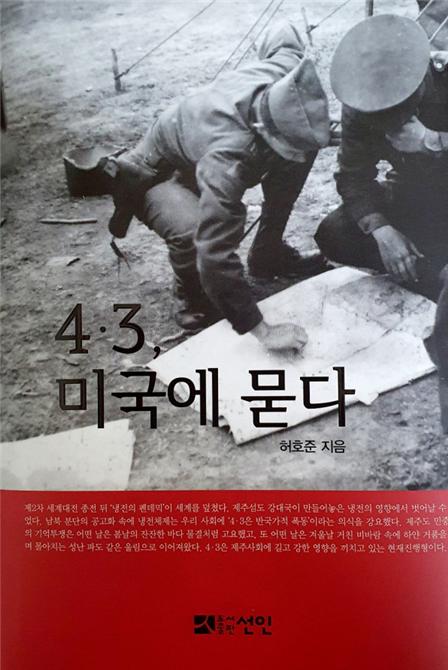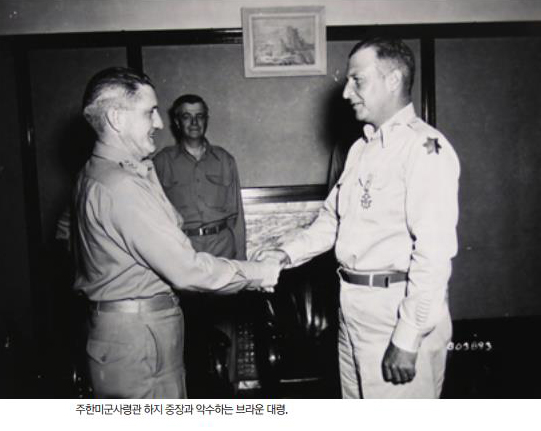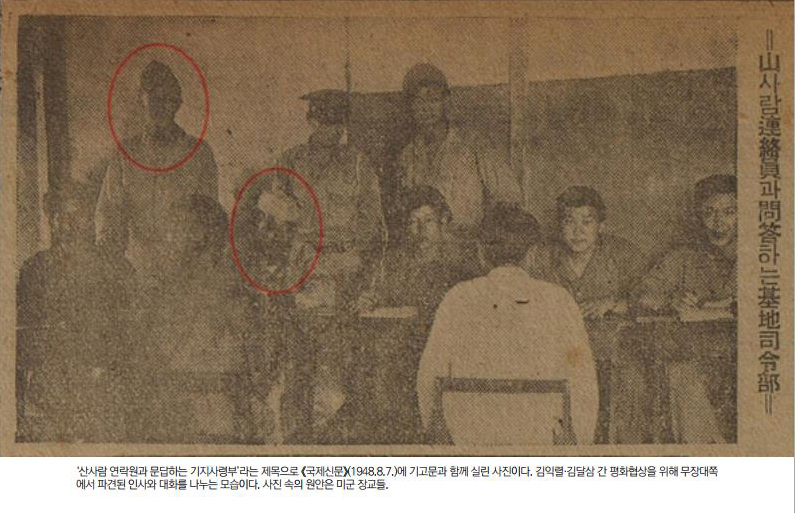Book Review for “Jeju 4·3 Questioning the United States”
Book Review for “Jeju 4·3 Questioning the United States”
Jeju 4·3, Questioning the United States Once Again

By publishing the book “Jeju 4·3, Questioning the United States,” author Huh Ho-joon successfully reconstructed and analyzed the causality of the affluent primary data. His elaborate exploration and argumentation on the proving data revealed the facts and traces of the U.S. intervention in Jeju 4·3. The book is the outcome of harmonizing his reportorial expertise as a fact-pursuing journalist and his academic aptitude as a scholar with a Ph.D. in political science.
Park Chan-shik
Historian, Former Advisor for Jeju 4·3 Incident Investigation Report
Work elaborated through his journey of life
“Jeju 4·3, Questioning the United States,” written by Huh Ho-joon, a senior staff writer with The Hankyoreh, is the first book to comprehensively analyze the relationship between Jeju 4·3 and the United States, and was published to mark the 73rd anniversary of the tragic event. The author focused on verifying the correlation between the U.S. intervention and the massacres of Jeju residents in the progression of Jeju 4·3, starting from the May 10 General Election to establish the South-side government in Korea. The book systematically arranged by each phase of Jeju 4·3 to address how the United States perceived and responded to Jeju 4·3 in the Cold War context, what efforts the United States Army Military Government in Korea (USAMGIK) put forth for the success of the May 10 General Election on Jeju Island, and what was the level of response by the USAMGIK after the election failed on the island as well as by the Korean Military Advisory Group (KMAG) and the American Mission in Korea (AMIK) after the establishment of the Republic of Korean government.
The author has covered Jeju 4·3 in numerous articles through his long career as a journalist and has also organized a special report on Jeju 4·3 issues. His experience related to Jeju 4·3 goes beyond the media world, in an even more diverse fashion. While working for the Jeju 4·3 Research Institute, the nation’s only private-sector research group on Jeju 4·3, the author in 2000 and 2001 undertook translating and publishing collections of U.S. documents related to Jeju 4·3. After starting his postgraduate program, he focused on revealing the correlation between Jeju 4·3 and the United States through his master’s thesis in political science. His doctoral dissertation broadened the horizon of research topics on Jeju 4·3 to the globe through a comparative study of Jeju 4·3 and the Greek Civil War. Moreover, he fully utilized his linguistic ability for the study, incessantly searching for data on the Internet and exchanging emails with those in the United States who are believed to have been involved in the Jeju 4·3 issues. In 2001, he finally went to the United States to meet and interview those who served as KMAG officials for the 9th Regiment of South Korea’s National Defense Guard on Jeju Island (NDG Jeju 9th Regiment) during Jeju 4·3. He also secured valuable research documents, such as operation logs and photographs. Needless to say, the book was born from extensive work by the author who devoted much of his life’s journey to exploring Jeju 4·3.

Col. Rothwell H. Brown (left) shakes hands with Lt. Gen. John Hodge, commander of the US Forces in Korea.
Written with a perspective of journalist and scholar
By publishing the book, Huh successfully reconstructs and analyzes the causality of the affluent primary data. His elaborate exploration and argumentation on the proving data revealed the facts and traces of the U.S. intervention in Jeju 4·3. The book is the outcome of harmonizing his reportorial expertise as a fact-pursuing journalist and his academic aptitude as a scholar with a Ph.D. in political science.
The author discovered countless new documents while writing this book. One of the documents states that during a meeting of the USAMGIK leadership held on May 5, 1948, on Jeju Island, Maj. Gen. William F. Dean, USAMGIK military governor, and Jo Byeong-ok, commissioner of South Korea’s National Police Agency, issued an “indiscriminate killing order.” He also discovered a document that proves U.S. President Harry Truman and U.S. congressional leaders were aware of the killing of countless Jeju residents. Other proving documents include the memoir that Song Yo-chan, commander of the NDG Jeju 9th Regiment, wrote about the anti-guerrilla warfare, various media articles from the United States and other foreign news outlets, and a considerable amount of digital materials obtained through Internet searches. This data was not cited when developing the Jeju 4·3 Incident Investigation Report in 2003, and they are highly valuable for revealing the United States’ intervention and responsibility regarding Jeju 4·3. Additionally, the author introduced in the book photographs, the NDG Jeju 9th Regiment operational logs, and oral testimonies from former KMAG members whom the author met in person in the United States in 2001 and contacted via email in 2007.
This book is a masterpiece with in-depth analysis and logical causality, centering on important data. The correlation between Jeju 4·3 and the United States was revealed clearly in this book through cross-analysis of previously cited documents as well as newly discovered ones. The essence of the book would be the revelation of the intervention by Lt. Gen. John Hodge, commander of the U.S. Forces in Korea (USFK), in particular his deployment of Col. Rothwell H. Brown to Jeju Island with orders to command hardline counterinsurgency operations. Brown’s dispatch occurred immediately after the May 10 General Election but discussion of sending him to Jeju began from the Peace Negotiations late in April and progressed to the USAMGIK leadership meeting on May 5. The book reconstructed the overall plot of Jeju 4·3 by conceiving the United States as a central axis, thus sufficiently revealing the U.S. intervention and responsibility.
The chapter titled “Jeju 4·3 and the US: A Daily Log” allowed for a better understanding of the United States intervention in Jeju over time. The chapter sufficiently heightens the academic value and credibility of the book by additionally presenting high-resolution original photo copies of ordered indexes and detailed endnotes, and the records of interviews with former KMAG officials. However, the first part of the book could provide an overview and commentary that outline the types of Jeju 4·3-related U.S. materials, characteristics of those authorities who produced them, and the system, locations, and holders of the documents.

The photo “U.S. Naval Base Headquarters Question Contact Persons with Mountain People” was released in the Aug. 7, 1948, edition of Kookje Shinmun. U.S. officers talk with people dispatched from the armed guerilla forces during peace negotiations between NDG Jeju 9th Regiment Commander Kim Ik-ryeol and armed guerilla forces Commander Kim Dal-sam.
Jeju 4·3, questioning the United States once again
The author himself acknowledged the limits of the book that the truth has yet to be revealed. He commented that the undiscovered documents and photographs include: the inspection report of the March 1 police shooting written by the USAMGIK Special Inspection Office, the documents of the USAMGIK written in response to the peace negotiations between the NDG Jeju 9th Regiment and the armed guerilla forces, the meeting minutes of the Jeju provincial leadership dated May 5, 1948, and the documents concerning the martial order and/or the scorched earth operations issued by the U.S. Department of State or the USAMGIK. Particularly, the author confessed that the book lacks the accounts of U.S. responsibility due to the decisive materials showing the U.S. intervention in the period of scorched earth operations still missing.
The author also wrote in the header, “I failed to show a deeper insight into the relationship between Jeju 4·3 and the United States beyond revealing the historical data, and it is because of my own limits.” Understandably, describing Jeju 4·3 with a focus on the surface of the U.S. materials will likely miss out on the hidden facts that could be found in the original meaning or connection with other historical materials. The book would be even more persuasive if historical methods were more carefully employed concerning the criticism of historical materials, causality, and perspectivism, as emphasized by historians.
A more challenging and bold analysis and description is required concerning hardline policies before and after the failed May 10 General Election, the 15,000 victims of the scorched earth operations, the USFK report on the plan for massacres using the NDG Jeju 9th Regiment (“Program of mass slaughter among civilians”). He could also address the claims such as the “invisible hand” theory, the “scarecrow” theory, and even the statements by report developers that mismatched their writings. It is also necessary to actively interpret individual data based on the clear premise that all operational responsibilities of the South Korean constabulary forces, which were structured by the USAMGIK and the KMAG, must ultimately belong to the United States. Noticeably, the book cited materials that consistently used the term “15,000 victims,” although written at different times. The author should not bear the legal and academic burden concerning the approaches to uncover confidential data and determine the responsibility of the United States. The Jeju 4·3 Committee fact-finding team visited the National Archives and Records Administration (NARA) of the United States in 2001 but failed to obtain 4·3-related confidential documents that they had checked on the list of documents and records held by NARA. In 2019 when the investigation team of the Jeju 4·3 Peace Foundation visited again, it turned out the materials remained undisclosed for more than 70 years and the documents were still refused to be declassified. This proves that there are still realistic and practical limitations in identifying the extent of the United States intervention in Jeju 4·3. It is difficult to expect that the U.S. materials, which were not revealed even in public investigations by the South Korean government or the Jeju 4·3 Peace Foundation, will be discovered through individual efforts. Hopefully, such public efforts will be resumed in line with the ensuing legal investigation concerning the Jeju 4·3 Special Act, which was completely revised this year.
A more active discovery of confidential data and a bold interpretation that more clearly defines the responsibility of the United States will be the mission given not just to the author but also to public institutions and private Jeju 4·3 researchers. Therefore, I dare to expect the author and other researchers to question the United States, just as in the book “Jeju 4·3, Questioning the United States.”